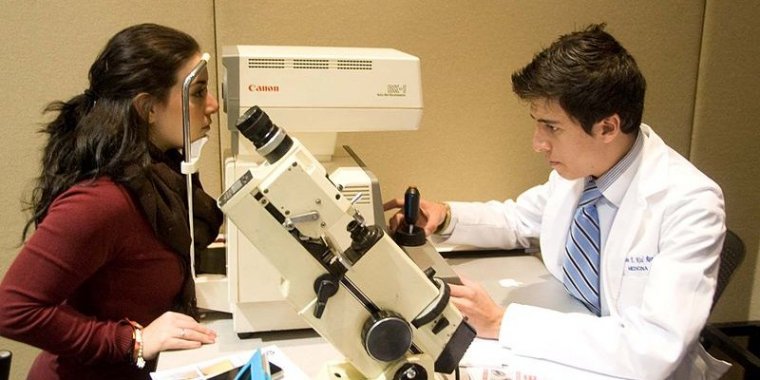| Health / Health News |
Predicting Alzheimer's Disease May Be Possible Using Eye Exam
Researchers have detected evidence suggesting Alzheimer's in older patients who had no symptoms of the disease by using technology similar to what is found in many eye doctors' offices.

Predicting Alzheimer's disease may be possible using eye exam. ![]()
"This technique has great potential to become a screening tool that helps decide who should undergo more expensive and invasive testing for Alzheimer's disease prior to the appearance of clinical symptoms," said the study's first author, Bliss E. O'Bryhim, MD, PhD, a resident physician in the Department of Ophthalmology & Visual Sciences.
Significant brain damage from Alzheimer's disease can occur years before any symptoms such as memory loss and cognitive decline appear. Scientists estimate that Alzheimer's-related plaques can build up in the brain two decades before the onset of symptoms, so researchers have been looking for ways to detect the disease sooner.
In previous studies, researchers examining the eyes of people who had died from Alzheimer's have reported that the eyes of such patients showed signs of thinning in the center of the retina and degradation of the optic nerve.
In the new study, the researchers used a noninvasive technique -- called optical coherence tomography angiography -- to examine the retinas in eyes of 30 study participants with an average age in the mid 70s, none of whom exhibited clinical symptoms of Alzheimer's.
"In the patients with elevated levels of amyloid or tau, we detected significant thinning in the center of the retina," said co-principal investigator Rajendra S. Apte, MD, PhD, the Paul A. Cibis Distinguished Professor of Ophthalmology and Visual Sciences. "All of us have a small area devoid of blood vessels in the center of our retinas that is responsible for our most precise vision. We found that this zone lacking blood vessels was significantly enlarged in people with preclinical Alzheimer's disease."
The eye test used in the study shines light into the eye, allowing a doctor to measure retinal thickness, as well as the thickness of fibers in the optic nerve. A form of that test often is available in ophthalmologist's offices.
For this study, however, the researchers added a new component to the more common test: angiography, which allows doctors to distinguish red blood cells from other tissue in the retina.
In the patients whose PET scans and cerebrospinal fluid showed preclinical Alzheimer's, the area at the center of the retina without blood vessels was significantly larger, suggesting less blood flow.
The retina and central nervous system are so interconnected that changes in the brain could be reflected in cells in the retina. (Tasnim News Agency)
YOU MAY ALSO LIKE

